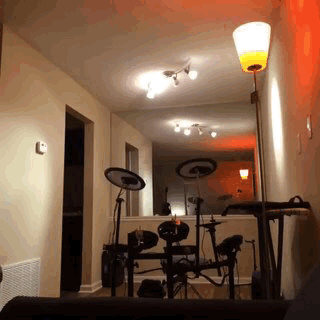In which I wire up Twilio to my lights, in an effort to appease my neighbors…
I am a drummer, the noise-polluting bane of apartment dwellers everywhere. In an effort to find some sort of balance (read: not get kicked out of the complex), I picked up one of these so that I can shunt most of that noise into my headphones:

Turns out though, if you hit a piece of plastic with a stick hard enough, it still makes a non-trivial amount of sound. To make matters worse, you have to wear headphones if you want your drums to sound like drums and not sticks-hitting-bits-of-plastic … so I’d be completely oblivious if my neighbors called or started banging on a wall to complain about all the racket.
This is the point where a reasonable man would just go talk to his neighbors and hash out a compromise.
I, however, am not a reasonable man.
Overengineering a Solution
I’ve had a set of Philips Hue bulbs ever since seeing them at a previous ATLRUG meetup 1. So here’s the idea: spin up a Rails app on Heroku and integrate with Twilio and the Hue API so that people can text a number to turn my lights red and I’ll know to stop. ‘Tis a gift to be simple.
The full app is on Github, but here are the interesting bits:
How Many Developers Does It Take …
The Hue bulbs have a fairly well documented API and there are some gems available. Unfortunately those are primarily focused on interacting with a set of bulbs on your local network, which won’t cut it if we want to toggle the bulbs from Heroku. Fortunately, I know that e.g. the official Hue app can reach the bridge from an external network, so this must be possible …
Turns out it’s actually not too painful. The tricky part is getting an access token, and the trick to that is essentially pretending to be e.g. an iPhone app trying to register.
Once you’ve got your access token, using it is quite straightforward:
class Light
include HTTParty
base_uri "https://www.meethue.com/api"
default_params token: ENV.fetch("HUE_ACCESS_TOKEN")
def self.alert!
call "PUT", "groups/0/action", '{"on":true, "sat":255, "hue":0}'
end
private
def self.call method, endpoint, message
clip = %|clipmessage={
bridgeId: "#{ENV.fetch 'HUE_BRIDGE_ID'}",
clipCommand: {
url: "/api/0/#{endpoint}",
method: "#{method}",
body: #{message}
}
}|
post "/sendmessage", body: clip.squish, verify: false
end
end
Since this app is public / hosted on Heroku, I’m using ENV variables to store sensitive information and dotenv to manage those locally.
The clipmessage / sendmessage business is essentially just a way to wrap up a regular API call and execute it remotely. In my case, I’ve already set up and hardcoded a group (/groups/0) consisting of the bulbs downstairs by the drums. With that in place, turning on the red light is just a matter of setting a few attributes on that group: {"on": true, "sat": 255, "hue": 0}.
Receiving Texts with Twilio
Twilio provides several communication automation services, and I’m using their SMSs. If you’re playing along at home, you’ll need to register a number and record your account SID and auth token, as well as getting a few credits for your account ($1/mo per number plus ¢¾ per text). From there, the twilio-ruby gem makes things fairly simple.
First, we need to route incoming texts to an action like
class MessagesController < ApplicationController
# Requests should be cross-site, so disable CSRF
skip_before_filter :verify_authenticity_token
def create
# Make sure we only respond to requests actually
# coming from Twilio
if params[:AccountSid] != ENV.fetch("TWILIO_ACCOUNT_SID")
raise "Unexpected message sender"
end
message = Message.create!(
from: params[:From],
body: params[:Body]
)
Light.alert!
message.reply "Roger! Keeping it down momentarily…"
# Twilio doesn't much care about what we send back
# but we don't want to 500 on failing to render
# a template
head :no_content
end
end
Message here is just an ActiveRecord which saves incoming messages and allows us to reply to them like so:
class Message < ActiveRecord::Base
def reply text
twilio.messages.create(
from: ENV.fetch("TWILIO_NUMBER"),
to: self.from,
body: text
)
end
private
def twilio
@_twilio ||= Twilio::REST::Client.new(
ENV.fetch("TWILIO_ACCOUNT_SID"),
ENV.fetch("TWILIO_AUTH_TOKEN")
).account
end
end
The full app has some other features - error monitoring, email notifications, and a traditional form input … but that’s the MVP.
Living With It
I’ve had an earlier version of this app “in production” for several months now, and it has been used in earnest exactly zero times. Turns out the walls are pretty thick, and my neighbors are pretty cool. Also, people are quite a/bemused when you tell them about a project like this, which garners some goodwill. But hey, now I can do this:

Rock on.
A request: in the spirit of civility, please don’t find and abuse the Heroku app. I’d just as soon not have to implement an IP whitelist.
1) http://atlrug.com but the specific talk seems to predate the archives and my recollection is hazy, unfortunately.↩